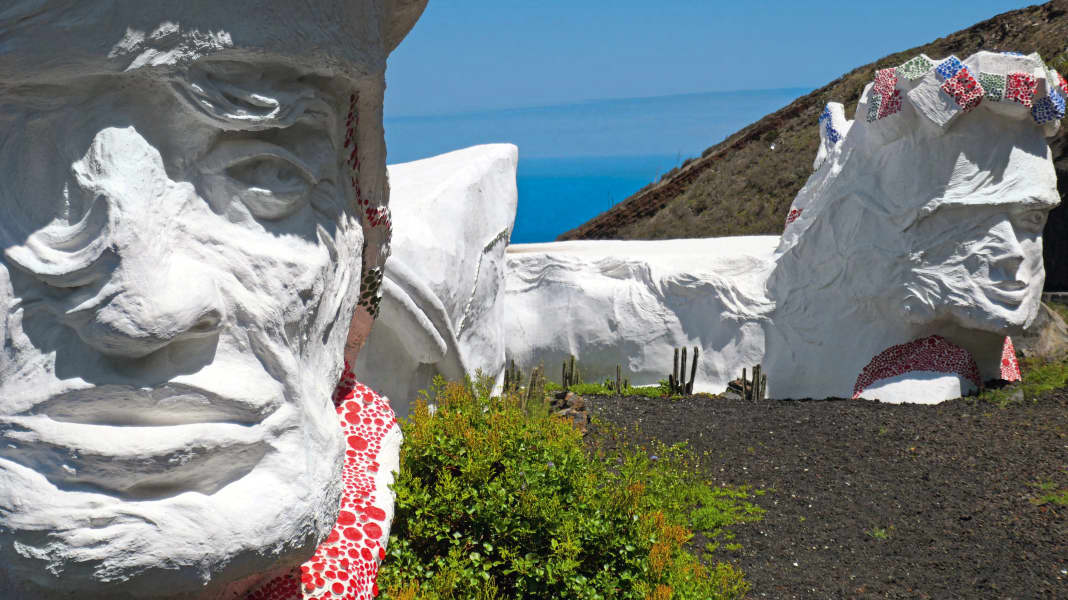
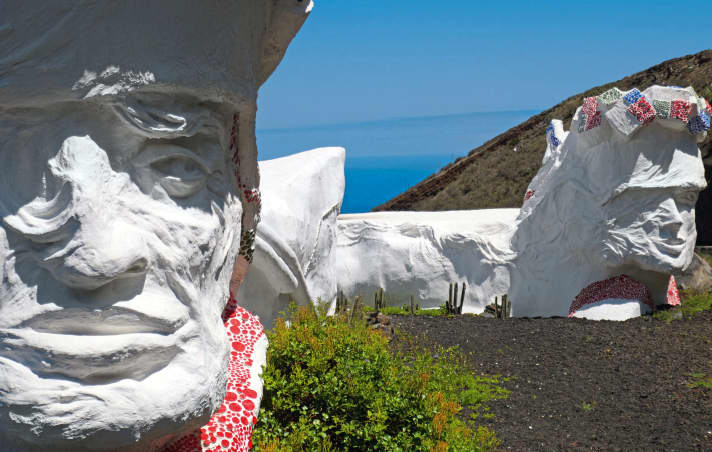
from Bernhard Riedel
It should be a dream sailing day! We, a crew of seven oldies aged between 61 and 75 from the northernmost part of Upper Bavaria, are still motoring in the lee of La Gomera. We enjoy a pleasant 22 degree air temperature, the deep blue Atlantic and the sun, which is only rarely obscured by a few fair weather clouds. The only thing missing for perfect happiness is a few more than the five knots of wind from the north. But the archipelago makes up for it in its own way: Shortly ahead, curved dorsal fins suddenly protrude from the water. There are about 15 pilot whales calmly making their way. Every now and then they blow their jet into the air, demonstrating animal composure. They accompany us for almost an hour.
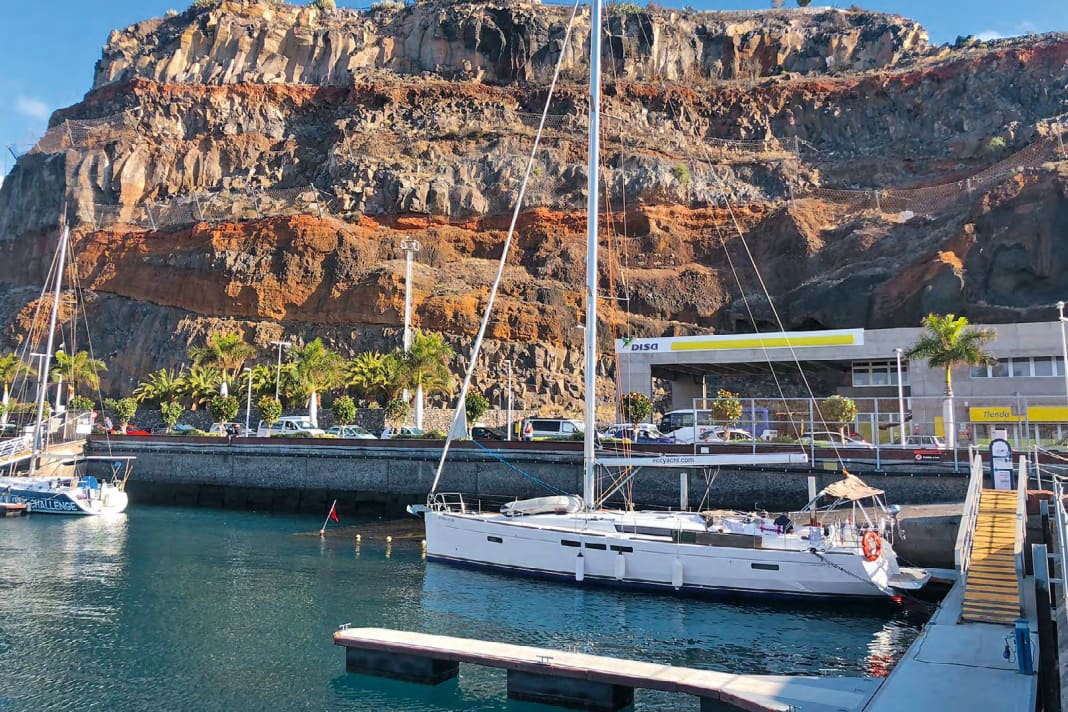





We leave the leeward side of the island early in the afternoon. The wind not only picks up quickly, but gusts of up to 27 knots are suddenly blowing in the rig. We have entered one of the wind acceleration zones, a typical phenomenon in the Canary Islands with their seven islands. We want to head for the most westerly of them. The island mountains, which are almost 4,000 metres high, force the northeast trade wind, which otherwise blows at a moderate 15 to 18 knots, through the passages between the islets. In certain areas along the coasts, this doubles the wind speed. Added to this are waves up to three metres high, which make the ship dance. Tranquil family sailing is different, Atlantic standards are applied here.
Western Canary Islands: over to El Hierro
We quickly reef the main and genoa and speed across to El Hierro, the smallest and southernmost island in the Canary Islands, at almost nine knots. It is an exhilarating experience, even if it does get wet in the cockpit from time to time: Strong winds, bright sunshine and waves well above deck height that crash under the keel of our yacht.
El Hierro is already our second destination, having previously travelled to La Gomera. A full 14 days are planned not only for exploring these two islands, but also for Gran Canaria and La Palma. From previous canoe trips, we know that you need time because of the sometimes large distances between the islands if you want to see not only the water and waves, but also the fascinating landscapes and beautiful towns and villages. Two visiting days are planned for each island.
Strong winds, bright sunshine and waves piling up behind the stern - that's a sailing holiday in the Atlantic swell
However, right at the start of the journey from Las Galletas in the south of Tenerife, we have to change our route plan. Due to repairs still to be carried out on the boat, we can only start our chartered Sun Odyssey 519 "Tefiti" after a delay. Unfortunately, Gran Canaria is not going to happen. Instead, we set course directly for La Gomera. These first 31 nautical miles are already as tough as the first leg described above. At our destination, we are allocated a berth in a corner of the rather crowded marina in San Sebastián. The hefty 76 euro overnight fee is quickly forgotten after a shower, a good dinner and a worthy end to the day in the cockpit.
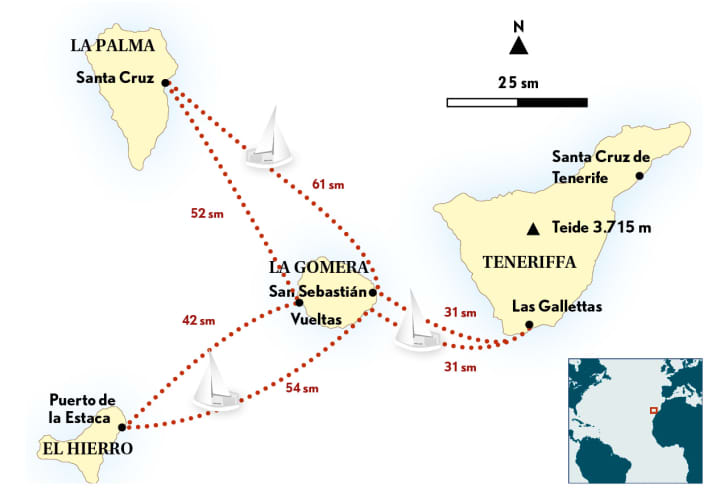
We fill two days with a hike through the fairytale-like, bizarre laurel forest in Garajonay National Park. Over a coffee in Valle Gran Rey, we observe the now older members of the hippie and drop-out scene. They established themselves here in the 1960s, and today many young people with guitars and rucksacks still populate the black beach. We take a hire car uphill and downhill over mountains covered in cacti and agaves and through valley gorges. The motorcyclists Reini, Hubert and Norbert in our crew can't get over their enthusiasm for the excellently developed roads, including the extreme bends: "You can forget about the Stelvio Pass and the whole of the Alps!"
We marvel at the mighty remaining plugs of former volcanic vents, and time and again pretty little villages with well-kept restaurants and cafés invite us to take a break. In the harbour of Vueltas, huge rays beg for food at a staircase leading into the water and would, it seems, love to climb the steps. The multiple variations of rugged volcanic landscapes, the subtropical to Mediterranean flora, the endless possibilities for outdoor activities, the secluded beaches in dreamlike bays: it's hard to say which is more impressive. And so our curiosity and anticipation for the next islands grows considerably.
This might also interest you:
If you want to visit several of them, you have to be prepared for sailing days of 35 to 65 nautical miles. That means six to ten hours on the water. It never gets boring: in the lee of the islands, we pick up a book or play card games. Once we are out of the wind cover, the peace and quiet is over. Then the waves lift the ship and crash under the keel, foaming and gurgling. This goes on for hours and has an almost magical, meditative quality.
After the whale encounter, we now set course for Puerto de la Estaca on El Hierro. In 2015, this was still an almost empty small boat harbour. Today it is equipped with floating pontoons and water and electricity connections for every berth. There is plenty of space and the harbour master helps with mooring. In general, it is noticeable how eager, open-minded and friendly the staff in the harbours and marinas are. All the officials speak English and we are always told that we are welcome.
A new, somewhat oversized harbour office building dominates the forecourt. The separate shower and toilet block, on the other hand, is rather sparsely equipped with two clean showers and toilets each. We are familiar with this from many marinas on the other islands. But above all, at 29 euros a berth, Puerto de la Estaca is one of the cheapest harbours in the area.
The day doesn't get too long after that. Crew member Robert serves delicious spaghetti carbonara, after which we sit together for a while and talk about the big and small problems of the world; after all, it is the skipper who is the first to retire to his bunk. Sailing in choppy seas was exhausting.
Western Canary Islands: Shore leave on El Hierro
"Hiring a car is difficult today," explains José from the information stand in front of the harbour office in good German the next morning. "Corona, Easter holidays, lots of tourists and a cycle race in the south of the island - all the cars are gone!" But then he keeps phoning around - and is successful. Shortly afterwards, two small cars are waiting for us and the tour of the island can begin. It quickly becomes apparent: El Hierro is very different to La Gomera. Rugged cliffs and steep coasts with hidden bathing bays initially dominate the landscape. In the interior of the island, on the other hand, pastures and fields with their stacked stone walls are almost reminiscent of Ireland. The carefully selected locations and sometimes very elaborately designed miradores, viewing platforms, are also typical. The most spectacular, the Mirador de la Peña, was designed by the famous architect Cesar Manrique using only local materials and plants. From the terrace of the restaurant, you have a wonderful view over the El Golfo coastline.
Unfortunately, low-hanging clouds do not allow the colourful flowers to really come into their own during our visit. In the south of the island, on the other hand, the sun warms up gentle hills, vast lava fields and extensive pine forests. The weather on the islands is often divided into two parts: In the north, the clouds accumulate on the mountains and bring moisture, while in the south it is bathing weather.
Co-sailors Wuni and Willi rush our two seats along the extremely steep and winding roads until we reach the Malpaso at an altitude of 1,501 metres via washed-out forest paths and the southernmost point in Europe, Punta da los Saltos near the village of La Restinga. Boat workshops and diving schools dominate the small harbour, while cafés and restaurants line the harbour promenade. Some of us dare to take a quick dip in the 18-degree water, but are soon dried off by the sun on the wooden jetty.
We enjoy an excellent dinner in the "Aguadara" in Guachinche, a rustic and - if it hadn't already become quite chilly in the evening - cosy restaurant without any touristy frills. Especially recommended: tender braised kid in a flavourful sauce. The Canary Islands are still an inexpensive place to eat. We pay between 105 and 145 euros for complete menus for seven people, including drinks. No matter where we stop off during the cruise, the dishes are always delicious and varied. Even if the density of restaurants and pubs is nowhere near the Mediterranean level, which also applies to the maritime infrastructure in general. Nevertheless, some marinas have been redesigned or modernised.
Western Canary Islands: Crossing to La Palma
Due to the birthday of fellow sailor Reini, whom we celebrate at midnight, we are a little tired when we set off for La Palma the next morning. We make a stopover in Vueltas in the west of La Gomera, in the direct neighbourhood of Valle Gran Rey. We find a suitable space for the boat on the inner quay of the harbour and tie up alongside. In view of the three metre tidal range, it's best to give enough line. We are surrounded by a colourful fleet of smaller fishing boats and moored in front of the two gigantic boulders guarding the valley. A wonderful end to another fantastic day of sailing: four to five Beaufort from the north pushed us the 42 nautical miles with half the wind to the east. We were accompanied by dolphins several times and the sun quickly dried the spray. A delicious dinner in the restaurant, followed by a game of cards on board - "There are days when you can only grunt with satisfaction," summarises the skipper.
"A landscape painter could not have composed the colours blue, black, green and ochre in all their variations more harmoniously"
The last 52 nautical miles to Santa Cruz de la Palma really challenge us for the first time. As soon as we leave the lee of La Gomera, we are hit by 26 knots of northerly wind. Heading upwind, the "Tefiti" bumps and pitches through the waves, getting stuck in the next one after each larger one. Spray sweeps across the deck, steering becomes exhausting, thick clouds cover the warming sun. Which means we've experienced pretty much every type of sailing on this trip. Except for storms, but we don't need that either, please! Once again, dolphins and pilot whales provide variety en route, otherwise everyone tries to protect themselves from the wind and water as best they can.
Western Canary Islands: Beware of the harbour of Santa Cruz
It is not only in the commercial harbour of Santa Cruz that registration is compulsory, i.e. you have to register by radio about two miles before arrival and then get permission to enter. You can't just enter the marina for pleasure boats either. This is because its entrance is closed by a bar. Only when this is lowered and the previously red traffic light turns green is the way clear.
In Spanish marinas, you first moor at the customs quay, complete the formalities and then get a berth. This time we have the full choice, less than half of the pontoons are occupied. The marina is modern and well-kept, with shops, cafés and fast food restaurants in the immediate vicinity.
La Palma is rightly nicknamed "the beautiful". The old town of Santa Cruz alone justifies this name with its architectural harmony, carved balconies, floral decorations, palm trees and colourful historic buildings. The numerous cafés, restaurants and narrow streets are a hive of activity. The variety of colours continues in the interior of the island: palm trees, agaves, cacti, dragon trees, some endemic plants and flowers proliferate lushly. They are radiantly illuminated by the sun and contrast with the vast black fields of ash and lava in the south, which still bear witness to the eruption of Teneguía in 1971. Pine and pine forests, artistically designed plazas such as Las Manchas, an interactive museum such as the Volcán de San Antonio with interesting insights into the geological history of the islands, in short: there is plenty to see and experience.
Rocky or gently curving bays, into which the dark blue Atlantic crashes with white crests of waves, complete the diverse impressions. At present, however, this colourful and cheerful picture is overshadowed by existential fear and uncertain future prospects for many families and businesses, as the recent eruption of the Cumbre Vieja has left devastating destruction in the western part of the island: Metre-high lava flows destroyed over 2,000 houses, plantations and industrial buildings. 7,000 people lost their homes. The magnificent mosaics of the Plaza of Las Manchas are covered in black ash, the sprawling plants dead. Houses that have remained standing but are abandoned because they are inaccessible, perched on hills in the middle of the lava, look like the last witnesses to a futile battle against the forces of nature. An employee of the tourist centre at Volcán de San Antonio puts it in a nutshell: "What are we supposed to do? The price is high for a life in paradise."
But we also came to La Palma to experience the Semana Santa processions. On Maundy Thursday and Good Friday, hundreds of masked participants parade through the streets. The beat of drums sets the pace, shrill trumpets mingle with the clatter of heavy chains attached to the feet of the faithful. In between, hooded men, who can only orientate themselves through narrow slits, drag heavy pallets with life-size depictions of the life of Jesus. It all blends into an eerie symphony and casts a strange spell over us. Fellow sailor Norbert says later: "It really made my hair stand on end! So creepy!"
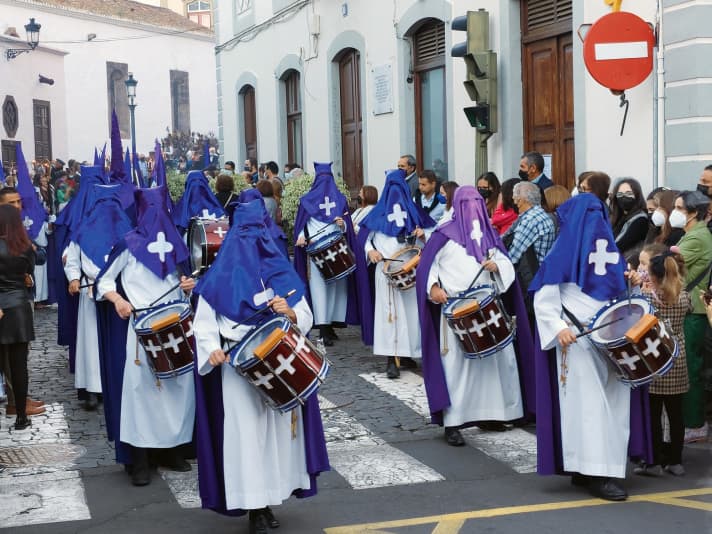
The next day, the steep hairpin bends up to the 2,426 metre high Roque de los Muchachos are not the only highlight. "This is pure jungle, it's unbelievable how many extreme vegetation zones there are on a single island!" marvelled Willi. Shortly afterwards, the magnificent view of the Caldera de Taburiente, a collapsed volcanic crater with a diameter of nine kilometres, is even more impressive. And if that wasn't enough, over 50 nautical miles away, the almost 4,000 metre high Teide on Tenerife stands on the horizon - a sight of rarely experienced intensity.
Two more marvellous sailing days await us, then we are back in Las Galletas. After all the experiences and impressions, some of the crew are probably convinced: This was not our last visit to the fascinating archipelago of the Canary Islands.
Cruise info
The precinct
The Canary Islands are not suitable for beginners. Some of the distances are long, there are few harbours and hardly any anchorages. The trade winds between the islands sometimes blow at over 30 knots and the waves can reach three metres in height. The tidal range is around 3.5 metres.
Journey
There are daily connections to the Canary Islands from almost all major German airports. Flight time around four and a half hours; prices 500 to 700 euros, depending on the season.
Charter
There are charter bases on Tenerife and Gran Canaria as well as on Lanzarote and Fuerteventura. The fleets are usually small and the range is manageable. Prices for a 40-foot boat are around 1,900 to 2,500 euros, for a 50-foot boat around 3,000 to 5,000 euros per week. Some of the boats are chartered for longer periods. Our
Sun Odyssey 519 (built in 2017) from ECC Yacht Charter cost around 3,800 euros/week, was well maintained and adequately equipped, but a little run down. October to March is high season, in summer most of the boats are transferred to the Balearic Islands. Then there are transfer offers.
Harbour handbook
Anne Hammick: "Atlantic Islands" (in English), RCC Pilotage Foundation, 59.80 euros.

